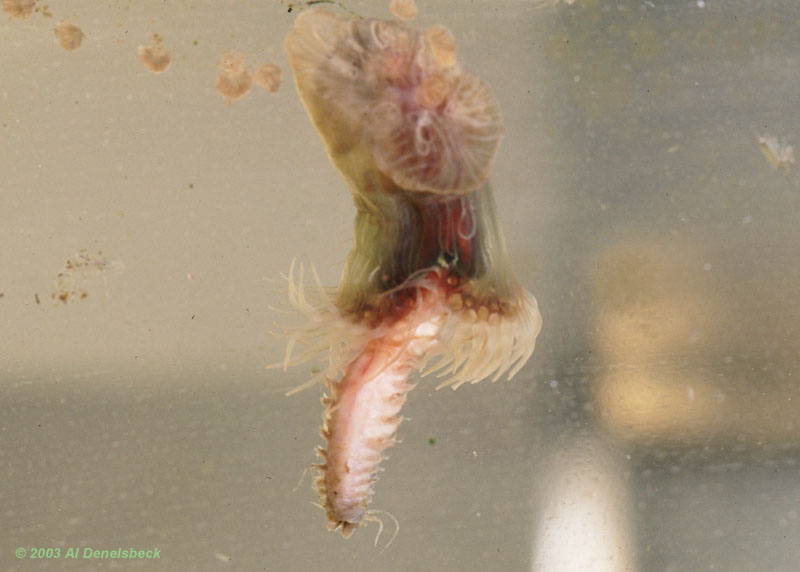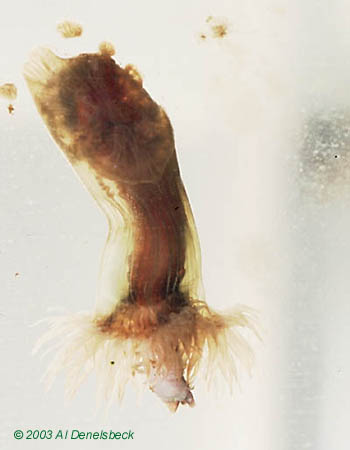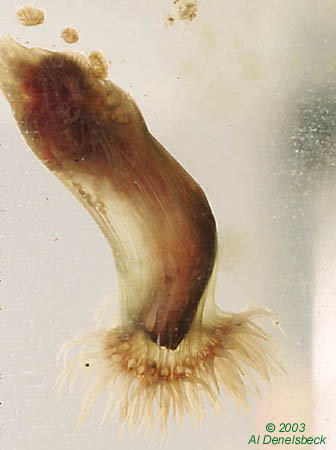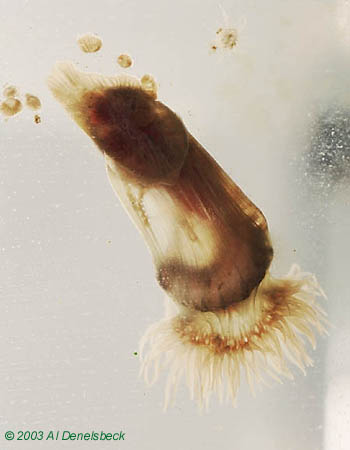Canon Elan IIe, tripod
380EX flash off-camera for partial sidelighting
Sigma 105 Macro w/ 36mm extension tube
Fuji Provia 100F
f11 at 1/125
|
Canon Elan IIe, tripod |
| Not For The Fainthearted | |
 |
|
As indicated, this is a small photo essay, life and death in my aquatic ecosystem. So a little background is needed:
One evening I caught a tiny little fast moving animal in the water, and had to examine it carefully in the light once I got home. It was about 2.5cm (1 inch) in length and resembled an eel in habits, very rapid moving and hard to see any detail on, but I was able to make out a series of appendages along the body, so more than anything it resembled a caterpillar. A very fast one, which I have since been informed is an annelid (thanks David!).
Once in the tank it commenced a hyperactive circuit, and blundered twice into one of the anemones, the largest one, who had taken up position on the wall of the tank up near the top where the annelid was swimming. The anemones very clearly have a venom of sorts, much like jellyfish, and I've actually been stung while cleaning the tank, but the most it produced on me was a mild itching that went away very quickly. On the annelid, the venom appeared to have a momentary affect, causing the critter to slow down abruptly and become extremely lethargic, before it shook the affect off after a few seconds and re-commenced its rapid pace. So I surmised that the venom was too weak to affect its metabolism.
Then it disappeared after the first night, and I figured one of the crabs had caught it. Until it reappeared one week later, as hyperactive as the first night. And again, it blundered into the anemone, slowed for a moment, then swam off without any loss of energy.
But it was only a matter of time. I turned back to the tank a few minutes later and was greeted with the scene above. Apparently the anemone had succeeded in snagging the worm during its brief lethargy after being stung, and once trapped, the repeated stings could maintain an effect. I quickly set up the camera and recorded the following sequence.
|
The annelid was much longer than the anemone's normal stalk length, but the nem was up to the task. Over the next several minutes, I witnessed the worm struggling sleepily while gradually getting further down into the anemone, while the anemone stretched way out of normal proportions to retain its meal. Even after being totally engulfed, the annelid was still struggling very slowly, as shown by the position in the last pic. What's also visible are the dark smudges of newborn nems around the base of this one, which it pumps out in vast numbers; and the fact that while I thought the sides of the tank were sufficiently clean, the flash revealed some water spots on the acrylic. Another lesson learned – polish the sides meticulously. About twenty minutes after the last photo, all signs of the annelid had vanished completely. This was so abrupt, to my thinking, that I examined the tank carefully to see if it hadn't actually escaped again, or been ejected as indigestible by the anemone – no sign of it was seen. It's still possible that it was ejected, and a crab quickly caught it, but it also might be an indication of the fierce digestive properties of the Aiptasia. All I know is, I was a lot more careful where I put my hands in the tank after that. |
 |
 |
 |
